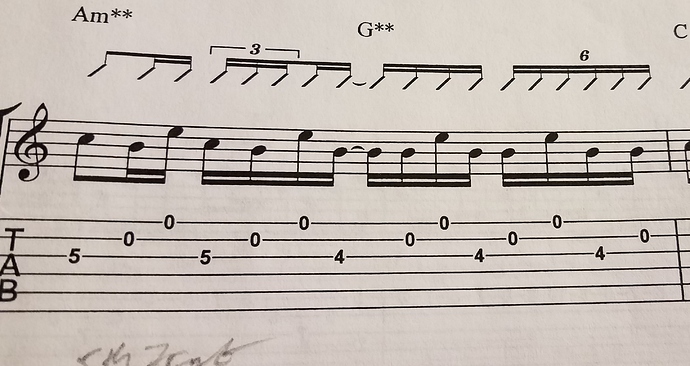First, I’d like to clarify that this is my first post on this forum, so hopefully I made sure to post correctly and all.
Secondly, I’ll be discussing in this post 1nps arpeggios, over three strings, only in ONE direction (i.e., note on G-string, note on B-string, note on E-string, then back to G-string).
Ascending:
E-------x-----x-| OR Descending: |x-----x-----|
B-----x-----x---| |--x-----x---|
G---x-----x-----| |----x-----x-|
D --------------| |------------|
Obviously repeated indefinitely.
A good example too would be Al’s arpeggios in Short Tales of the Black Forest.
Some background: I’ve only ever seen these arpeggios cross picked or outside picked. For achieving very high speeds, only outside picking–strictly one directional lines. When they’re two directional, i.e.:
E|-----x-------x----| Or even: |-----x-----x-----x----|
B|---x---x---x---x--| |---x-----x-----x---x--|
G|-x-------x-------x| |-x-----x-----x-------x|
Cross picking is by all means the way to go.
I guess I have a couple parts to this:
- Has anyone ever seen these sorts of one way rolls done with other picking permutations?
- Thoughts on picking these inside vs. outside (or any other permutation)?
- My thoughts within that last two weeks after working on these for years: outside picking is “superior.” My question: why?
- For these ONE way rolls, where does cross picking stack up vs. outside or inside picking?
So the first time I came across this type of pattern was from a duo, Rodrigo y Gabriela (R&G), and the arpeggios popped up more often than not in their rep. Obviously I went through the normal, let me sweep this with all down strokes, to no avail. Then I read an article released with a lesson they did, where the picking was described as “down, down, up.” Al di meola talks about this in his REH video, as have other guitarists I’m sure.
Now the particular pattern in this R&G arpeggio has a rest every other time around on the note on the G-string. So I thought that performing this pattern as “up, down, down,” or picking it inside, made more sense: there was a rest every other time that would give me the time to hop back over the G-string I just played before hitting the B-string with a down stroke… rather than lifting over the G-string before the rest, down stroke it, have the rest, then down stroke the B. Playing the line outside seemed counterintuitive, and it still does.
Regardless, I struggled with these arpeggios for awhile, slowly saw more and more instances where guitarists would play them outside, and tried to break the economy down. Thinking about just pure triplets, no rests in between notes or funky rhythms, in theory there’s no difference between inside and outside picking.
This is the case with Troy’s Paul Gilbert anti-gravity episode, but applied to normal scalar lines, and that’s the same conclusion I draw with these arpeggios: the distances traveled to cross the string is the same in both instances. The only difference is whether its before or after the note is played, and utilizing them in a scalar sense is situational, depending on direction, phrase, etc.
I figured the same goes for these arpeggios, and I continued picking them inside for the longest time, having hit a speed roadblock at the same time.
About two weeks ago, I finally said, okay, I have yet to see these picked inside at the speeds I’m trying to get to, I’ve been working on cross picking for a hot minute, and for the past year I’ve been introducing myself to outside picking more rigorously. I’m gonna crank these arpeggios out with outside picking.
Two practice sessions later of just me and a metronome, switching between inside, outside, cross picking, and one other permutation, I’ve surpassed my speed limit and noticed a couple things. For one, there’s a stronger tone from the low note, the consistency between all three notes far surpasses inside picking, and it feels 100 times easier and cleaner than it ever did, and does, with inside picking.
After reading about a month ago this forum post:
I feel like it might be onto something. From my own experience, picking these arpeggios outside is far superior for high speeds, even when the particular pattern would make more economical sense with a different permutation. Has anyone else come across this? Has anyone tried other permutations for these and gotten better results than with outside picking? Does anyone else find that outside picking these is better than inside picking them?
Keep in mind that I’m mostly comparing inside and outside picking for these arpeggios; I believe cross picking has better place with lines in two directions rather than one, although pretty high speeds can be achieved with cp even in this one directional case.

